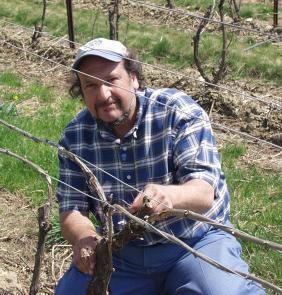Francis J. Ferrandino

Dr. Ferrandino taking bark samples at a commercial vineyard.
Department of Plant Pathology & Ecology
123 Huntington Street
New Haven, CT 06511
Voice: (203) 974-8504 Fax: (203) 974-8502
E-mail: Francis.Ferrandino@ct.gov
Education:
B.S. Elmira College (1973); summa cum laude, Mathematical Physics
M.S. Rensselaer Polytechnic Institute (1980); Astrophysics
Ph.D. Rensselaer Polytechnic Institute (1980); Astrophysics
Station career:
Assistant Scientist June 1982
Associate Scientist 1995
Scientist 2014-2020
Emeritus Scientist 2020-present
Past research:
The application of diffusion-reaction equations to biological problems,e.g.:The turbulent dispersal of pollutants in a run-of-the-river reservoir. Mathematical models of phenological development. Turbulent dispersal of airborne fungal spores. Epidemiological models of Late blight on potato and Septoria leaf spot on tomato. Cultural methods for management of eggplant, potato and tomato plants affected by Verticillium wilt. Epidemiology of Nectria canker of Black Birch.
Current research:
Combination of on-site weather measurement, inoculum quantification and mathematical epidemiological models of plant disease to predict disease-risk for winegrape growers in Connecticut. Development of analytical tools for the description of spatio-temporal patterns of disease.
Selected publications available from the author, Francis.Ferrandino@ct.gov
- Ferrandino, F. J. (1993). Dispersive epidemic waves: I. Focus expansion within a linear planting. Phytopathology, 83, 795-802.
- Ferrandino, F. J. (1996). Two-dimensional distance class analysis of disease-incidence data: Problems and possible solutions. Phytopathology, 86, 685-691.
- Ferrandino, F. J. (1996). The length scale of disease spread: Fact or artifact of experimental geometry. Phytopathology, 86, 806-811.
- Ferrandino, F. J., and W. H. Elmer. (1996). Septoria leaf spot lesion density on trap plants exposed at varying distances from infected tomatoes. Plant Dis. 80,1059-1062.
- Ferrandino, F. J. (1998). Past nonrandomness and aggregation to spatial correlation: 2DCORR, a new approach for discrete data. Phytopathology (Letter to the Editor) 88, 84-91.
- Ferrandino, F. J. (2004). Measuring spatial aggregation in binary epidemics: Correlative analysis and the advantage of fractal-based sampling. Phytopathology, 94, 1215-1227.
- Ferrandino, F. J. (2005). The Explicit Dependence of Quadrat Variance on the Ratio of Clump Size to Quadrat Size. Phytopathology, 95(5), 452-462.
- Ferrandino, F. J. and Smith, V. L. (2006). The effect of milk-based foliar sprays on yield components of field pumpkins with powdery mildew. Crop Protection, 26(4), 657-663.
- Wu, B. M., Subbarao, K. V., Ferrandino, F. J., and Hao, J. J. (2006). Spatial analysis based on variance of moving window averages. J. Phytopathology,154(6), 349-360. https://doi.org/10.1111/j.1439-0434.2006.01105.x
- Ferrandino, F. J. (2008). The effect of crop growth and canopy filtration on the dynamics of plant disease epidemics spread by aerially dispersed spores. Phytopathology, 98(5), 492-503.
- Bock, C. H., T. R. Gottwald, P. E. Parker, A. Z. Cook, F. Ferrandino, S. Parnell, and F. van den Bosch. (2009). The Horsfall-Barratt scale and severity estimates of citrus canker. Eur. J. Plant Pathol., 125, 23-38.
- Bock, C. H., T. R. Gottwald, P. E. Parker, F. Ferrandino, S. Welham, F. van den Bosch, S. Parnell. (2010). Some Consequences of Using the Horsfall-Barratt Scale for Hypothesis Testing. Phytopathology, 100(10), 1030-1041.
- Ward, J. S., S. L. Anagnostakis and F. J. Ferrandino. (2010). Nectria Canker Incidence on Birch (Betula spp.) in Connecticut. Northern J. Appl. For., 27(3), 85-91. http://dx.doi.org/10.1093/njaf/27.3.85
- Ferrandino, F. J. (2012). Time Scales of Inoculum Production and the Dynamics of the Epidemic. Phytopathology, 102(8), 728-732. DOI: http://dx.doi.org/10.1094/PHYTO-03-12-0051-LE
- Ferrandino, F. J. (2013). Relating the progeny production curve to the speed of an epidemic. Phytopathology, 103, 204-215. DOI: http://dx.doi.org/10.1094/PHYTO-04-12-0093-R
- Anderson, J. F., A. J. Main, P. M. Armstrong, T. G. Andreadis, and F. J. Ferrandino. (2014). Arboviruses in North Dakota, 2003–2006. Am. J. Trop. Med. Hyg. 92(2), 377-393. http://dx.doi.org/10.4269/ajtmh.14-0291
- J. F. Anderson, F. J. Ferrandino, M. P. Vasil, R. H. Bedoukian, M. Maher, and K. McKenzie. (2017). Relatively small quantities of CO2, Ammonium bicarbonate, and a blend of (E)-2-Hexenal Plus (E)-2-Octenal Attract Bed Bugs (Hemiptera: Cimicidae). Journal of Medical Entomology, 54(2), 362-367.

